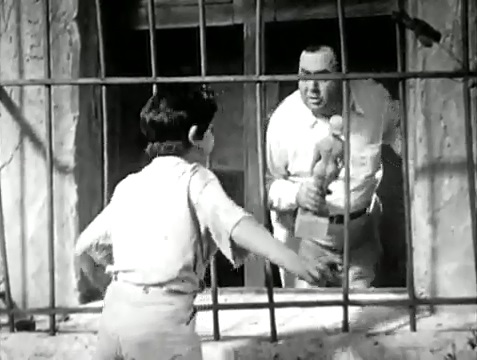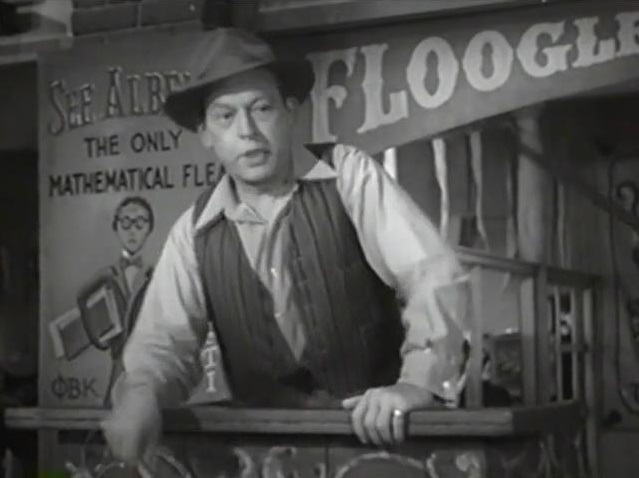Raggedy
Rose
Mabel Normand for Fanny Brice, so “second-hand” she
makes like cats to collect the junk people throw at them. Ragpicking’s steady work. “——Who
stole my lunch? ——” It’s on
her behind.
The wealthy and
eligible is sought by Anita Garvin, his manservant’s James Finlayson. “—Stop quarreling with
yourself——and bring my pajamas——”.
Titles by H.M.
Walker. Directed “in collaboration with Stan
Laurel”. A Pathécomedy.
It goes into Life Stinks (dir. Mel Brooks). “The Ritz-Carlton was crowded so she slept in the
annex.” Max Davidson is her partner in the
business. If you’re hit by a car, they tuck you
in bed at the hospital and feed you. She can’t
make a go of it, her behind again.
Nevertheless,
unconscious she’s taken to the wealthy and eligible’s
nearby and put to bed. Mrs. Crab wrestling her out of
her clothes goes into Howard & Asquith’s Pygmalion. It’s the hospital, she
thinks, and he’s a doctor in his white robe, “——The
Prince of her dreams——”, they met in the alley when he threw
a boot at the “cats” and knocked her out. “—Oh
Doctor—I feel so terrible—I’m so hungry—I must have a
dozen ham and eggs——”. Garvin’s
mother says, “—I know all about these cases—I’ve been
struck by several cars——”. A
masterpiece of comedy. “—Drive the ladies
home, Jerry—And order me a new car tomorrow—”.
Thunder
Below

Petroleum-scouting
very far south of the border, cf. Mervyn LeRoy’s Oil
for the Lamps of China. The little Spanish town of
Huston’s The Treasure of the Sierra
Madre is just the same, right down to the Shinola.
From
Pinter’s Tea Party (dir.
Charles Jarrott) to Renoir’s Woman on the Beach (again with Bickford). “‘I admit Beatrice’ he said kindly
‘and the brothel, Beatrice after the brothel or the brothel after
Beatrice, but not Beatrice in the brothel, or rather, not Beatrice and me in
bed in the brothel.”
Then
there’s the man from the Continental. “Listen,
I could outsnore any
six Gordon Highlanders.” Los tres jinetes
at the village fiesta.
Mordaunt Hall of the New
York Times, “monotonous... Ken is moderately
well played by Paul Lukas, who might better have been cast as Davis,
impersonated by Ralph Forbes. And Mr. Forbes would
have fitted the part of Ken admirably.” Leonard Maltin, “melodramatic”. Nicole
Gagne (All Movie Guide),
“romantic-drama weepie.”
Halliwell’s Film Guide,
“dreary”, citing Variety, “dull”.
Wedding
Present
The fine line
between genius and madness, a bride and a bromide, Gotham and Gomorrah. The greatest emergency ever faced by New York, bigger
than bankruptcy, more absolute than Arabs steering jets into skyscrapers.
Went over the head of Variety, right past B.R.
Crisler of the New York Times and into Halliwell’s
Film Guide with an asterisk.
How Milestone’s The Front Page became
Hawks’ His Girl Friday.
The Young In Heart
Children and
confidence tricksters (“card-sharpers...
fortune-hunters”) can be observed as charming and generous in certain
ways, also as “rotters... parasites... hard as
nails” and so forth. The game
is a mother’s love, or more precisely that of a foolish woman whom sorrow
has made wise through the years, and the playing of it is explicated in
Mackendrick’s The Ladykillers up to a point, also Ulmer’s St.
Benny the Dip (cf. Malle’s Crackers).
Critics follow Variety,
it seems, “beautiful and deeply touching”.
Bombardier
It has one and
only one point to make, dramatic or otherwise, and that is the new role of the
man at the bombsight, he wrests command of the plane for the bomb run, a matter
of “thirty seconds” or even twenty, a notion elsewhere accepted but
here found controversial, so that (as in Preminger’s The Court-Martial of Billy Mitchell) it must be tested at the
outset. The scenic effect of representing the
months before Pearl Harbor and an early bombing raid on Japan is to give a
terrible picture of aerial warfare, both on the ground at Nagoya and above.
Crowther’s table
was set on a roar, “a cheap, fictitious film,” he considered it,
“RKO, John Twist and Richard Wallace, the writer and director, should
hang their heads in shame” (New
York Times). For Halliwell, “totally
routine”.
The Fallen Sparrow
A film in the
form of a dream, an analysis of The Maltese Falcon (dir. Roy Del Ruth or John Huston) or
Satan Met a Lady (dir. William Dieterle) set in
November 1940, the beauty is that liberation from torture and imprisonment two
years after “the Spanish war” doesn’t mean the end of strife,
on the contrary.
There is an objet,
and a gang, but it’s set in New York among the Park Avenue set doing
refugee work, there’s a famous Norwegian historian who knows all about
“scientific torture”, and a dead detective, and femmes who
might be fatales, and an old prince with a strong sense of heritage and
tradition down to banners and crests. The MacGuffin is
a brigade battle-standard sought by a vengeful Nazi who goes back to “the
beer-hall days”.
The ending and other details also recall Casablanca (dir. Michael Curtiz).
T.S. of the New York Times found it
well-directed and led by Garfield satisfactorily, and but for that
“merely far-fetched and macabre”.
It’s in the Bag!

Fred Allen,
“in Hollywood all a producer produces is relatives,” this picture
is directed by “Mr. Skirball’s
father-in-law, another relative,” on The
Twelve Chairs and a flea circus. After that brief
prologue, Wallace takes over in the grand style to which his genius is
accustomed. The influence of Keep Your Seats, Please!
(dir. Monty Banks) on the same subject is apparent. Woody Allen, son of Fred.
Shades of Hamlet, a murdered granduncle (cf. Roy Del Ruth’s Topper Returns). Mrs.
Nussbaum, Jack Benny, a psychiatrist, Zombie
in the Attic, Phil’s Naughty Nineties with Victor Moore and Rudy Vallee and Don Ameche
(“times got tough”), a gangster whose birthday party goes into Robin and the 7 Hoods (dir. Gordon
Douglas), the real plotters... Wedding of the
exterminator’s son and the flea king’s daughter.
Bosley Crowther of the New
York Times, “a dizzy, bewildering picture... rat's nest of nonsense...
defies the sober description of a comparatively rational mind... catch-all of
Allen witticisms, wisecracks and comedy routines... sack of silly salad...
story of sorts... just a crossfire of gags.” Leonard Maltin, “plot soon goes out
the window in favor of unrelated but amusing episodes.”
TV Guide, “a small but
lively comedy.” Hal Erickson (All Movie Guide), “any number of
hilarious tangents.”
Halliwell’s Film Guide,
“patchily amusing”, citing Richard Mallett in Punch,
“untidy... doesn’t make the most of itself...full of fun.”
Sinbad the Sailor
The Eighth Voyage
of Sinbad, a masterpiece of masterpieces in a pure, continuous style often
approached but never neared, emulated but not equaled.
The poisoned
water on a salvaged vessel, the fair maid, the foul ruler who besets the hero
(telling it all in Basra), the gold of Alexander, the blessing of the Prophet,
are too much for the likes of anyone, let alone Bosley Crowther
of the New York Times, “the somewhat bookish writers who prepared
his lengthy script were no Scheherazades at telling
an engaging tale”, followed by Dave Kehr (Chicago
Reader), “campy
swashbuckler”. The script is of the utmost
brilliance (“obscure”, said Variety). “Humourless” (Halliwell’s Film Guide).
The discovery of
the Aga is an effect achieved later on by Michael
Anderson in Logan’s Run (the forsaken Capitol).
Framed
The Fallen
Sparrow analyzed and refined to a
still abstraction, almost a schematic layout. A
banker’s son-in-law falls out of the nest into an embezzlement plot with
a pretty mistress employing a ringer (cf. Boetticher’s
“Point Blank” for Maverick), she
takes the ringer for a ride instead.
He’s a
mining engineer, he assays the ore. A mirror
arrangement, embezzler and ringer, she feathers her nest with their plumage.
It made A.W. (New
York Times) think of Garnett and Wilder, he saw the layout and thought it
too pat. “Script doesn’t have too much
finesse”, Variety said.
Tycoon
He had been an
engineer in his youth, the film gives a picture of his transformation, dividing
him into the title character (Sir Cedric Hardwicke)
and a young engineer (John Wayne) building a railroad for him, thus also the
unfinished tunnel and the bridge threatened by flood.
This structure
and arrangement seems to have been confusing to critics, even audiences. Claude Berri’s Manon
pictures were a long way off, the engineer stays one, the tycoon takes a
holiday, the titanic struggles were described as “slow and
overlong” by A.W. of the New York Times, a “boring,
studio-set action saga with too many stops for romance” in Halliwell’s
Film Guide (the engineer marries the tycoon’s daughter).